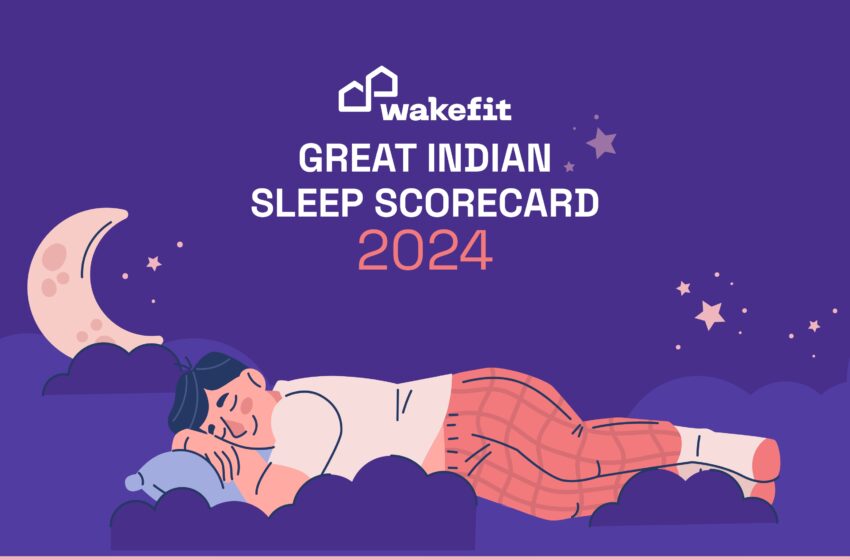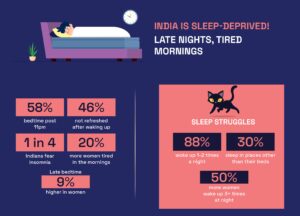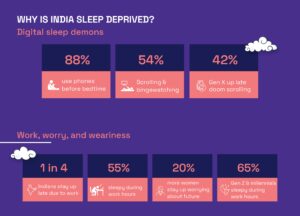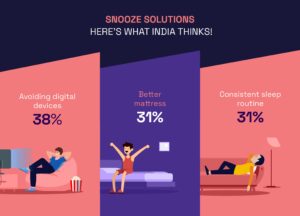Insights into India’s evolving sleep patterns

Team L&M
D2C sleep and home solutions providers, Wakefit.co, has released the 7th edition of its Great Indian Sleep Scorecard (GISS) 2024. With close to 2.5 lakh responses garnered across seven years and 10,000+ responses this year, the GISS study highlights key observations in India’s sleep patterns.
While comparing the sleep patterns of Indians over the years, several notable differences emerge. While the percentage of individuals going to bed after 11 PM has slightly increased in 2024 from 55per cent in 2023 to 58per cent in 2024, women consistently show a higher percentage compared to men. There has been a downward trend in feeling refreshed upon waking up, particularly among women, since 53per cent feel that. Despite a slight decrease in the use of phones before bedtime, it remains prevalent, indicating persistent challenges with digital device usage impacting sleep quality. Insomnia concerns also continue to persist, with a significant portion of the population reporting waking up multiple times during the night, emphasizing the ongoing importance of addressing sleep health in India.
KEY INSIGHTS
Midnight Marathons Maintain Momentum among Indians: Despite advocacy for early bedtime, the percentage of people going to bed after 11 PM has risen from 55per cent in 2023 to 58per cent in 2024. While 41per cent of individuals under 18 years old go to bed after 11 PM, this figure rises to 48per cent among those aged 18 – 30 and declines to 25per cent among those above 45. Within this, the percentage of women going to bed after 11 PM continues to be higher as compared to men, with 61per cent women and 56per cent men in 2024
The ongoing “Snooze Struggle” persists as data from 2024 reveals that 46per cent of individuals find themselves not feeling refreshed upon waking up, a notable increase from the 41per cent reported in 2023. This trend is particularly pronounced among women, with the proportion rising from 47per cent to 53per cent. Similarly, among men, the percentage rose from 39per cent to 44per cent. This consistent uptick prompts a crucial inquiry: are these figures indicative of entrenched poor sleep habits or perhaps reflective of underlying factors impacting sleep quality?
Digital Midnight Musings: A growing awareness of the importance of avoiding digital devices and maintaining consistent sleep routines is evident, with 69per cent of individuals recognizing these factors for better sleep, up from 64per cent in 2023. Despite this heightened awareness, the prevalence of smartphone usage just before bedtime remains high, with only a marginal decrease from 91per cent in 2020 to 88per cent in 2024. This discrepancy suggests that while people acknowledge the detrimental effects of digital device use on sleep quality, behavior change remains a challenge. Consequently, digital devices, particularly smartphones, continue to pose significant disruptions to sleep patterns across both genders. It’s noteworthy that concerns about the future weigh heavily on the minds of individuals under 18, while midnight social media browsing emerges as a prevalent activity among those aged 45 and above.
Solutions for better sleep: The findings show how different age groups prioritize different factors to improve sleep quality. Younger populations, notably those aged 18 to 30, emphasise their importance of avoiding digital devices before bedtime for better sleep. In contrast, people aged 35 to 44 have a larger preference for mattress quality, with 42per cent feeling that a better mattress can improve sleep. Furthermore, data emphasizes the importance of keeping a consistent sleep habit across age groups, highlighting its function in supporting better sleep quality. Also with 70per cent people responded admitting to not sleeping in areas other than their beds, this shows that people prefer to sleep in their bed room, therefore can we look at how we can make the sleep environment at home more appealing for people to have a quality sleep?
Insomnia Concerns continue to persist: A staggering 29per cent of Indians express worries about suffering from insomnia, marking a notable uptick in concerns about sleep quality. These anxieties cut across gender lines, with 32per cent of females and 28per cent of males sharing similar apprehensions. The data delves into the demographics, revealing that individuals above 45, despite prioritizing early bedtimes, harbor the highest suspicions of insomnia, closely trailed by the 18 to 24 age bracket. Moreover, there’s been an 82per cent surge in individuals waking up multiple times nightly in the age bracket of above 60, highlighting prevalent sleep disruptions likely influenced by health factors. Among the younger generation concerns about the future contribute significantly to staying up late, affecting 35per cent of women and 29per cent of men in addition to occupational demands necessitating late nights. This escalating trend of insomnia, evolving from 22per cent of females and 17per cent of males in 2020 to higher rates in subsequent years, underscores a pressing issue demanding proactive intervention.
Commenting on the report, Chaitanya Ramalingegowda, Director and Co-Founder of Wakefit.co, emphasized the significance of understanding and addressing the evolving sleep patterns of Indians. He stated, ” Our annual Great Indian Sleep Scorecard illuminates India’s evolving sleep landscape with close to 1 Lakh responses over seven years. Despite heightened awareness, lifestyle pressures continue to impact sleep quality, underscored by rising digital device addiction. While people increasingly recognise the value of quality sleep, cultural shifts are imperative to prioritize sleep health and enhance overall well-being. We believe that the findings from the Great Indian Sleep Scorecard serve as a valuable resource for individuals, organizations, and policymakers striving to promote a culture of sleep positivity and well-being.”
The Great Indian Sleep Scorecard is an ongoing survey aimed at capturing and analyzing sleep trends and patterns across India. The 2024 edition received 10,000+ responses and covers respondents in all Indian cities, across age groups and various demographics. The survey has collected close to 2.5 Lakh responses to date over seven editions.





